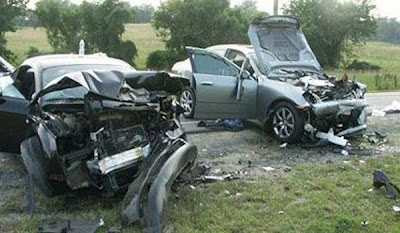Each year...going back decades...tens of thousands of people are killed on North American asphalt and cement.
And nobody blinks. (Well, they blink...but they also shrug; it's regarded as nothing more -or less- than the cost of doing business in a automobile-centric world.)
Each year, governance gets mucked-up on just about every level imaginable.
And while people do more than blink...not much changes within the constructs. Bad voter turnout is bemoaned, another effort at generating greater urgency next time is begun...but generally, people shrug, and as their governance 'goes south', they return to their couches and expand their fattening posteriors...and vow to 'vote the bums out!' next time.
I read an interesting article recently having to do with car innovation. Manufacturing engineers have been providing more and more 'safety features' not just to have a leg-up on the competition, but to compensate for the fact that there is an ever-widening chasm easily referred to as 'driver capability'.
Let me rephrase that: engineers are having to make up for the fact that people don't take driving seriously enough...and the licensing bodies are complicit in this...to want to take their skills far enough along the continuum of proficiency.
They're making up for the fact that people just don't care.
People are lazy about their driving.
There's little pride in the skill.
Motorists just want to get to where they're going...period.
They can't be bothered to bring to bear any effort towards excellence...beyond passing the required tests.
And so evidently, automobile manufacturers are doing what they can to reduce the depth and breadth of that aforementioned 'chasm'. When really, given how many people die on North American highways each year...never mind the injured and the maimed...doncha think if we had half a collective brain in our collective heads, we'd do what we could to equip ourselves better?
But driving is seen as a 'right'. Not a privilege, as it actually was intended, and worse, not an honourable skill to be learned, developed, honed. (Such a 'right' that the taking away of a person's license is seen as a last resort, a horrible assailing of individuality, a 'right' so deeply embedded in our car-centric culture that a 15 year old recently took out the family fan for a joyride...and in the mayhem that followed, a police officer was killed, and this teenager is, as I type this, a quadriplegic.)
Now, voting? Involvement and engagement in governance? Specifically the local variety?
Well, voting is a right. And people by-and-large tend to exercise this right just as mindlessly. People don't take it seriously. They don't put a lot of thought into it. (As I've yammered on about time after time on this blog.) And they certainly don't develop their skills, they don't hone their acuity over the course of time...mostly because they don't (again, by-and-large) get involved in their own governance, they don't put any time into engagement with their representatives at City Hall, they don't develop any deepening understanding of the process and how they can impact their very lives just by taking part.
So.
Imagine for a second roadways used by motorists who were markedly more proficient, substantially more skilled, who had a real relationship with driving, one where aptitude went hand-in-hand with a passionate desire to excel at moving these heavy conglomerations of steel and glass around. Imagine how much safer our streets and highways would be. Not only that, imagine how much more humane our urban roads would be walkability-wise.
Well, imagine as well, local governance where citizens not only took voting seriously...in fact, were so prideful of being able to cast a ballot that twice the numbers did the deed as generally do presently...but actually saw their role in the maintaining of their neighbourhoods, their communities, their city as being the equal of their elected representatives and of Council's supporting staffs.
It's astounding where the potent mélange of apathy and arrogance will take a society.
It's equally astounding to consider how different things could be if we charted a different course, 'north-northwest three and a half degrees', for example.
Maybe we need some 'astounding' in our lives, huh?








